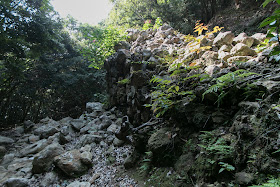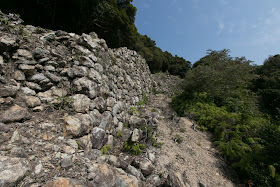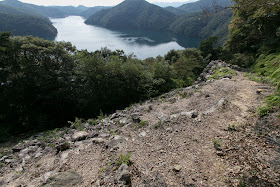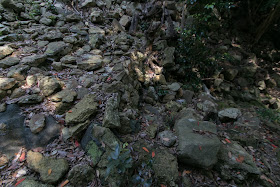Kaneda Castle
-Castles at forefront islands (2) 1,200 year unchanged border fortress-
Overview
Name: Kaneda castle (Kaneda-jo)
Alias:
Place: Mitsushima-cho Tsushima city, Nagasaki
Type: Mountain Castle
Built: 16th century
Remaining remnants: Stone walls, clay walls and ruins of modern battery
Title:
Brief History
Kaneda castle (金田城) is built over Jo-yama mountain, one of about 250 meter height from hillside faces Aso-wan bay, the one which separates main land of Tsushima island into its north half and its south half. Aso-wan bay is a good anchorage point with narrow entrance and numerous inlets with sufficient depth and it was critical to protect this bay not only to protect the island itself but also naval invasion to main land of Japan.
Tsushima island as a part of ancient Japan
Since ancient era, Tsushima island had been a part of Japan as described in the book of Wei, the official history of ancient Chinese Wei Dynasty described in the 3rd century. In that book, Tsushima island is described as a small nation reigned by Hiko and Hinamori and followed to the queen of Yamato Kingdom existed somewhere in the mainland of Japan.
In 6th century, Agata-no-atai clan which had relationship with Yamato Dynasty reigned Tsushima island at Kechi area, a small valley at the choke point of Tsushima island and built traditional Japanese style tombs at that area. This place was convenient to access both western coast and eastern coast of the island with good port.
At the same time, Korean peninsula was divided into three kingdoms, it mean Goguryeo Kingdom in the north half, Baekje Kingdom in the southwest part and Silla Kingdom in the middle eastern part. In the middle of 7th century, Silla kingdom allied with Chinese Tang Dynasty and attacked remaining two kingdoms.
Foreign campaign and severe defeat
In 660, Baekje Kingdom was ruined by Tang and Silla army. As Baekje Kingdom was close to Yamato dynasty, former retainers of Baekje Kingdom attempted to restore the kingdom under the prince stayed at Japan and asked assistance to Yamato Dynasty. Yamato Dynasty prepared restoration army and marched to the peninsula in 663.
But at that year, this alliance army of Yamato Dynasty and Beakje Kingdom suffered severe defeat by allied army of Silla and Tang at the battle of Baekgang, which occurred at the mouth of Geum river in southwest part of Korean peninsula. Yamato Dynasty which lacked experience to manage large army abroad lost many soldiers and ships, and had to seriously consider the possibility of attack to Western Japan.
Preparing for the invasion from the continent and peninsula, Yamato Dynasty built many mountain castles around north part of Kyushu island and Seto-naikai sea, to protect Dazaifu city which was the vice capital of Japan and prevent the movement of enemy fleet at the sea. Especially, from the loss of Baekje Kingdom, Tsushima island became the forefront island and had to face with the peninsula.
Build of multiple defense line
Yamato Dynasty at first prepared the communication line using signal fire from Tsushima island to Dazaifu city in 663. Beside this, the dynasty also placed guardians named as "Sakimori", drafted from eastern provinces and worked for three year period. This was a heavy duty apart from homeland and had to prepare the weapon and supply by themselves, and poems of these guardians were recorded in the anthology of this period.
Next, Yamato Dynasty built mountain castles utilizing the technology of Baekje Kingdom to build defense line. At first Mizuki fort was built in front of Dazaifu city, and next Onojo castle and Kii castle were built at both side of Dazaifu city. Being protected by two mountain castles and two clay walls, Dazaifu city became a fort complex.
After the fixture of Daizufu city, in 667, Yamato Dynasty built Takayasu castle (Osaka prefecture), Yashima castle (Kagawa prefecture) and Kaneda castle from the start, middle and end of sea lane from Kinki region, the main base of dynasty to the Tsushima island. Watch of enemy navy and endurance to the arrival of reinforcement army were required for these castles.
Structure of Kaneda castle
Kaneda castle was built utilizing long and narrow ridge of Jo-yama mountain spreads from the peak toward north, and another small ridge prolongs toward west. Same as Kii castle, the castle sharpened the ridge and uses as the line of wall, being enhanced with stone walls. Total length of stone walls is over 2 kilometers and usage of stone walls is greater than other ancient castles.
As the castle spreads over steep slope, only narrow flat area was built around the peak of the mountain. But at the halfway of eastern slope, there is relatively flat area and this part was used as the core part of the castle. At this part there remains the ruin of several barracks, and a stone made pocket warmer used by guardians was found at this area.
Among the clay wall of eastern coast, three gates were built utilizing small valleys. Each gate has tall stone walls at its both side and might have a barrack over the gate, like Kinojo castle. Stone walls are basically built placing small stones, but there are several projections built by large stones and have clear corner structure. These parts might be added at later period.
As a result, there was no invasion from continent and peninsula became the conflict between Tang Dynasty and Silla Kingdom. Ancient mountain castles ceased to be used in one or two century after the construction, Stones of stone walls were taken away or fell into the ground, and castles disappeared into the forest or ground,
Continuous invasions from peninsula
However, as a forefront island, Tsushima island had to face with continuous invasion from the peninsula. Especially in the latter half of 9th century, under the internal disorder of Silla Kingdom, Tsushima island faced several attack of Silla army but drove back these invasions. In response to this, central government kept Kaneda castle and Sakimori guardians at the island to protect the border firmly.
Especially in 894, over 2,000 soldiers of Silla army assaulted the island with over 100 ships for the purpose of plunder. The commander of Japanese army had only small army but broke Silla army utilizing ambush tactics and crossbows. It is recorded that it occurred under the order of Silla Kingdom, but the conflict of the border once stabilized after this incident.
However, at the invasion of Chinese Yuan Dynasty and Korean Koryo Kingdom in 1274 and 1281, Tsushima island was assaulted at first and suffered severe damage. Leaders of So clan which became the lord of Tsushima island died in the battle, and many residents were killed or kidnapped in the battle.
Crisis and foreign expedition
Furthermore, in 1419, army of Joseon Kingdom assaulted Tsushima island, then killed local people and burnt their properties. In response to this, the army of So clan which was still the lord of Tsushima island resisted against Joseon army at mountainous area and gave damage. As a result, Joseon army totally retreated from Tsushima island in 10 days without any dominance.
On the contrary, at the foreign expedition by central ruler Hideyoshi Toyotomi (1537-1598) in 1590's, Tsushima island became an important stopping point toward the peninsula. To protect the island as a strategic base and prevent the activity of foreign navy, Hideyoshi expanded Shimizuyama castle, a mountain fort of So clan at the middle part into a modern one equips stone walls.
Considering the importance of Aso-wan bay as an anchorage point, Kaneda castle might be reformed and used at this time. Small basements of buildings constructed by well shaped stone walls totally different from original walls might be added this time, which has same structure as Shimizuyama castle.
Among 250 years after this expedition Tsushima island experienced calm days under So clan which became the feudal lord under Edo Shogunate. However, in the last period of Edo era, the island became the point of struggle at the border of East China Sea and Sea of Japan, among the conflict of British Empire and Russian Empire.
Modern fortress against another opponent
In 1861, Russian fleet suddenly came to Aso-wan bay and illegally landed to the island then stayed over half year. Tsushima domain and Edo Shogunate suffered this incident, but finally under the pressure of Britain Russian fleet retreated and Tsushima island barely avoided its colonization.
After the Meiji Revolution, new government recognized the importance of Tsushima island and fortified the island as Tsushima fortress. The construction of Tsushima fortress started in 1887, just next to Tokyo Bay fortress which was the capital of Japan. At first small four fortress were built around at the inner part of Aso-wan bay next year.
10 years after that, reflecting the progress of cannons, larger cannons were built at backside mountains surrounding Aso-wan Bay. At this time, hilltop area of former Kaneda castle became the ground of Jo-yama battery again. Four 28 centimeter cannons were built, along with underground powder storage and soldier room. The place of ancient castle which looks down whole part of Aso-wan bay was still suitable after 1,200 years.
In 1905, during Russo-Japanese war, Japanese Navy intercepted Russian Baltic Fleet which passed Tsushima straight at the eastward of Tsushima island, and made total victory at the naval battle of Tsushima. If Japanese navy lost this battle Tsushima island might became the last fortress against the enemy but it was avoided. Tsushima fortress existed by the end of World War 2 and was abolished.
Significance of border fortress throughout Japanese history
Now both of ancient castle and modern fortress were abolished, but because of long time usage, structures of ancient castle best remains among ancient castles built at the same time. Jo-yama mountain is a steep one deep inside of the forest, but transportation path of Jo-yama battery becomes good approach route to the castle.
Border protection of distant islands had been a tough work from ancient era to the present. Being gifted its geographical condition Japan had been able to apart from border dispute relatively, but Tsushima island had survived continuous invasions by the efforts of nation and local residents.
Among the economical pressure from the opponent, border islands keep the basic stance of neighborly friendship but also makes unremitting efforts to stabilize the border. Kaneda castle holds the ruin of each era is exactly a symbol of border protection of Tsushima island by Japan over 1200 years, and it is hoped that this castle attracts more attention for disciplined peace of border islands under the tense international situation.
Access
15 minutes drive from Tsushima Yamaneko Airport to the entrance of military road along Prefectural Road 24. 15 minutes drive of forest road and 60 minutes walk to hilltop castle.
Related Castles
Shimizuyama Castle -Castles at forefront islands (2) corridor like castle protected corridor-











































































































































































































































































































































































































































No comments:
Post a Comment